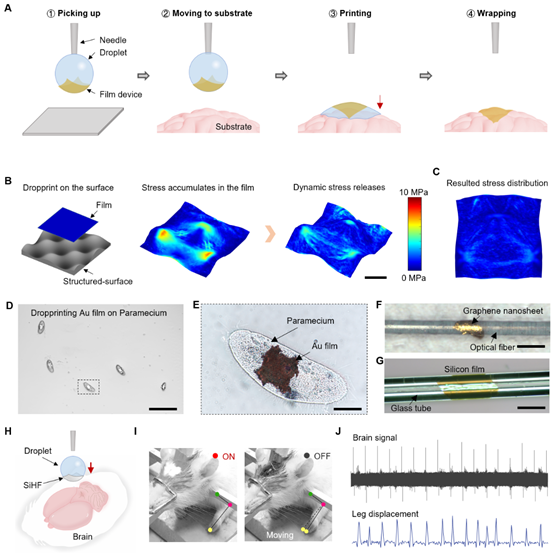Researchers Propose “Drop-Printing” to Construct Conformal Bioelectronic Interfaces
In recent years, with the rapid development of wearable electronics, neurorehabilitation, and brain-machine interfaces, there has been an urgent need for methods to conformally wrap thin-film electronic devices onto biological tissues to enable precise acquisition and regulation of physiological signals.
Conventional approaches typically rely on external pressure to force devices into conformal contact. However, when applied to uneven three-dimensional surfaces such as skin, brain, or nerves, these methods generate significant internal stress, which can easily damage fragile metal circuits and inorganic chips. This has become a major obstacle in the advancement of flexible electronics.
Prof. SONG Yanlin’s team at the Institute of Chemistry, Chinese Academy of Sciences, in collaboration with Beijing Tiantan Hospital, Nanyang Technological University, and Tianjin University, introduced a new film transfer strategy named as drop-printing. This method uses droplets to pick up and transfer ultrathin films. When deposited onto the target surface, the droplet forms a temporary lubricating layer between the film and the substrate.
This allows stress generated during film deformation to be dynamically released through localized sliding, thereby preventing device from rupture. Moreover, by controlling the dynamics of the three-phase contact line, the method achieves high positional accuracy.
Experiments have shown that drop-printing strategy not only enables the conformal wrapping of nanometer-thick, non-stretchable electronic films onto optical fibers, plant surfaces, and even microorganisms, but also allows for the transfer of stem cell films by adjusting the droplet composition.
In animal studies, 2 µm-thick silicon-based films were successfully printed onto the surfaces of nerves and brains, forming conformal bioelectronic interfaces. Using these interfaces, infrared light was able to induce periodic limb movements in the animals, demonstrating precise spatiotemporal control of neural activity.
By dynamically releasing stress during conformal deformation, this work provides new insight into the damage-free attachment of ultrathin films to complex three-dimensional surfaces. The strategy holds broad potential for applications in bioelectronics, flexible displays, and micro-/nano-manufacturing.
This study was published in Science.

Figure. Stress-free conformal wrapping of ultrathin films via drop-printing. (A) Schematic illustration of the drop-printing process. (B) Dynamic stress release enabled by localized sliding. (C) Stress distribution within the ultrathin film. (D, E) Conformal wrapping of gold films on Paramecium. (F) Graphene nanosheets conformally wrapped around an optical fiber. (G) Silicon membrane wrapped onto a glass tube. (H-J) Light-induced control of rat limb motion through drop-printed neural interfaces.
Contact:
Prof. SONG Yanlin; Prof. Li Huizeng
Institute of Chemistry, Chinese Academy of Sciences
Email: ylsong@iccas.ac.cn; lihz@iccas.ac.cn





